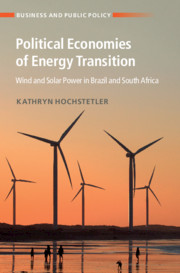Book contents
- Political Economies of Energy Transition
- Business and Public Policy
- Political Economies of Energy Transition
- Copyright page
- Contents
- Figures
- Tables
- Acknowledgments
- Abbreviations
- 1 Political Economies of Energy Transition in Brazil and South Africa
- 2 Wind and Solar Power in the Transition to a Low-Carbon Economy
- 3 States, Markets, and Energy Transition: Good Industrial Policy?
- 4 Electricity Consumption in Brazil and South Africa: Distribution and Prices
- 5 People and Place: Siting Wind and Solar Plants in Brazil and South Africa
- 6 Political Economies of Energy Transition
- References
- Index
4 - Electricity Consumption in Brazil and South Africa: Distribution and Prices
Published online by Cambridge University Press: 12 November 2020
- Political Economies of Energy Transition
- Business and Public Policy
- Political Economies of Energy Transition
- Copyright page
- Contents
- Figures
- Tables
- Acknowledgments
- Abbreviations
- 1 Political Economies of Energy Transition in Brazil and South Africa
- 2 Wind and Solar Power in the Transition to a Low-Carbon Economy
- 3 States, Markets, and Energy Transition: Good Industrial Policy?
- 4 Electricity Consumption in Brazil and South Africa: Distribution and Prices
- 5 People and Place: Siting Wind and Solar Plants in Brazil and South Africa
- 6 Political Economies of Energy Transition
- References
- Index
Summary
Citizens expect their states to provide basic electricity services, of acceptable price and quality. Wind and solar power have affected that by making electricity accessible for additional consumers, especially through local generation of solar power (distributed solar power), even as their prices have often been much higher than alternative electricity sources. This chapter examines how the Brazilian and South African states used wind and solar power to provide electricity services to their household and industry consumers. As electricity access was nearly universal in Brazil, wind and solar power’s primary contribution was to supply grid-scale electricity, along with a small number of solar installations for remote consumers. Growing controversies focus on the subsidies to small-scale generation and increased urban self-provision. In South Africa, wind and solar power entered a highly unequal electricity system – 32 companies used 40 percent of the electricity while the apartheid government had left Black South Africans unserved – and have done little to redress the inequalities. The same coalitions fought over the true price of electricity options as prices rose precipitously.
Keywords
- Type
- Chapter
- Information
- Political Economies of Energy TransitionWind and Solar Power in Brazil and South Africa, pp. 132 - 174Publisher: Cambridge University PressPrint publication year: 2020



